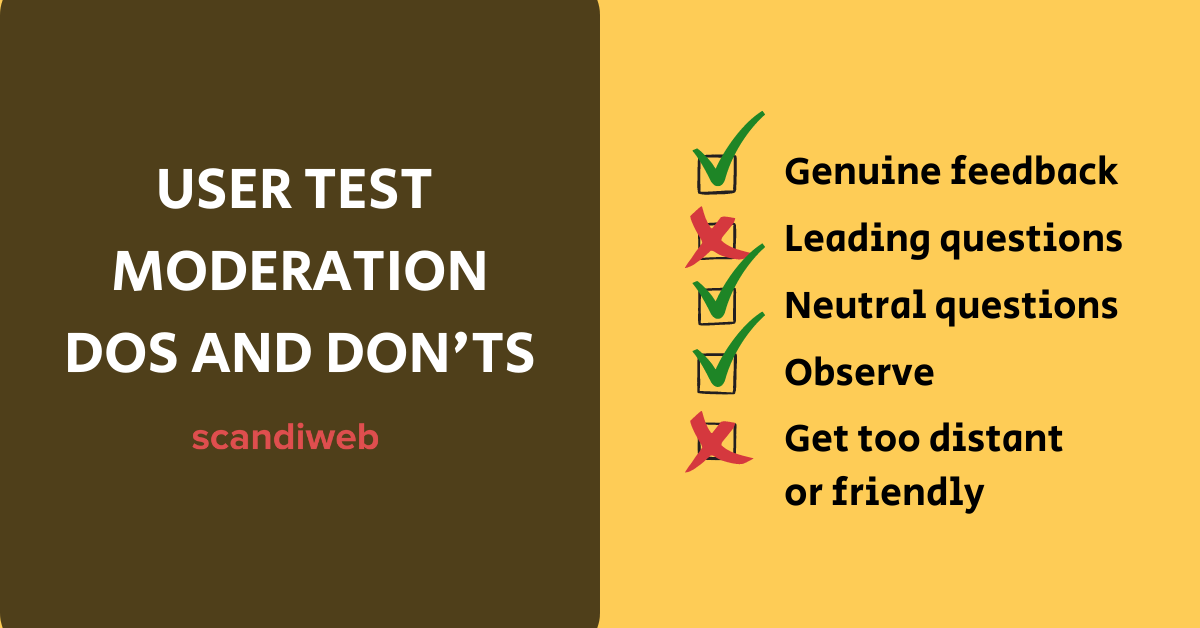User research involves a lot of steps and strategies. But here are basic things to remember when moderating a user test. Just keep in mind that the goal is to get honest, impartial feedback from the users at every level.
Here at scandiweb, we’ve run over 400 user tests. How to make sure the feedback you get is genuine? How to get the most out of user tests? Get our user test moderation learnings and tips in this webinar!
1. There are no right or wrong answers
At the beginning of every test, we always reassure users with this golden reminder: “There are no right or wrong answers. We just want to hear your opinion.”
It’s important to encourage users to give their honest feedback, whether positive or negative. They should not feel as if they are sitting for a school test. The unnecessary pressure of getting the right answers will only prevent them from providing the genuine feedback that we are after.
When testing a website’s menu structure, there may seem to be correct answers that respondents need to get to. Then again, the test is about finding out if users will take the path intended for them to take or not. It’s not the users’ fault if the navigation menu is too confusing to follow. The menu structure is what is being evaluated and not the respondents.
2. Rules for asking questions
Ask neutral questions
Move away from asking leading questions. Formulating a question in such a way that favors one side will most likely get you a one-sided answer. Asking neutral questions will ensure that you are not influencing the user’s train of thought in any way.
Leading question: “Was the checkout experience GOOD?”
Neutral question: “Was the checkout experience good or bad?”
Avoid YES and NO questions
Close-ended questions are useful for surveys or anywhere you want to get statistical results. Yes-no questions are fine with quantitative research that focuses on numbers. But if you are after user insights and a better understanding of user experience, you’d want to ask open-ended questions instead. Ask WHY and HOW to get more insights.
3. Observe the user
Observation is a powerful research method and especially useful for understanding what is happening beyond what respondents are willing to say or admit. Researchers can observe how people shop in stores, whether they can find the right products, how they read the information on the packaging, and so on.
In user testing, observing the participants’ behavior and facial expressions can reveal additional insights. Imagine this scenario: A user says that they did not experience any issues with a certain process, but then shows hesitation and confusion with their action and facial expression. Does it look like the process went as smoothly as verbally expressed by the user? Or perhaps not? People may not always want to admit that they are having difficulties with something, but the expression on their faces will usually give them away.
4. Find the balance between being distant and friendly
The way you interact with the user can greatly impact the feedback you get from them. On the one hand, if you are too distant and cold, the user might feel restricted and provide limited responses. On the other hand, if you are too friendly and warm, the user could get distracted and focus on giving you positive feedback just so you would like them. What you must do is find the balance between these two.
Need support in conducting user tests or setting up surveys for your eCommerce store? Our Growth Team can help with that and more. From UX improvements to conversion optimization, we have different programs to help you reach your eCommerce goals. Sign up for a free consultation today or hit the orange chat bubble on the right to talk to one of our project managers.


Share on: